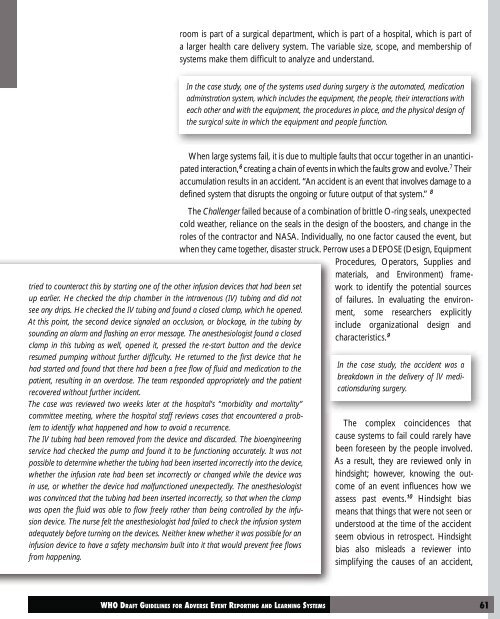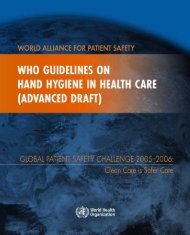Adverse event reporting.pdf
Adverse event reporting.pdf
Adverse event reporting.pdf
You also want an ePaper? Increase the reach of your titles
YUMPU automatically turns print PDFs into web optimized ePapers that Google loves.
oom is part of a surgical department, which is part of a hospital, which is part of<br />
a larger health care delivery system. The variable size, scope, and membership of<br />
systems make them difficult to analyze and understand.<br />
In the case study, one of the systems used during surgery is the automated, medication<br />
adminstration system, which includes the equipment, the people, their interactions with<br />
each other and with the equipment, the procedures in place, and the physical design of<br />
the surgical suite in which the equipment and people function.<br />
When large systems fail, it is due to multiple faults that occur together in an unanticipated<br />
interaction, 6 creating a chain of <strong>event</strong>s in which the faults grow and evolve. 7 Their<br />
accumulation results in an accident. “An accident is an <strong>event</strong> that involves damage to a<br />
defined system that disrupts the ongoing or future output of that system.” 8<br />
The Challenger failed because of a combination of brittle O-ring seals, unexpected<br />
cold weather, reliance on the seals in the design of the boosters, and change in the<br />
roles of the contractor and NASA. Individually, no one factor caused the <strong>event</strong>, but<br />
when they came together, disaster struck. Perrow uses a DEPOSE (Design, Equipment<br />
Procedures, Operators, Supplies and<br />
materials, and Environment) frame-<br />
tried to counteract this by starting one of the other infusion devices that had been set<br />
up earlier. He checked the drip chamber in the intravenous (IV) tubing and did not<br />
work to identify the potential sources<br />
of failures. In evaluating the environ-<br />
see any drips. He checked the IV tubing and found a closed clamp, which he opened. ment, some researchers explicitly<br />
At this point, the second device signaled an occlusion, or blockage, in the tubing by<br />
sounding an alarm and flashing an error message. The anesthesiologist found a closed<br />
clamp in this tubing as well, opened it, pressed the re-start button and the device<br />
include organizational design and<br />
characteristics. 9<br />
resumed pumping without further difficulty. He returned to the first device that he<br />
had started and found that there had been a free flow of fluid and medication to the<br />
patient, resulting in an overdose. The team responded appropriately and the patient<br />
recovered without further incident.<br />
The case was reviewed two weeks later at the hospital’s “morbidity and mortality”<br />
committee meeting, where the hospital staff reviews cases that encountered a problem<br />
to identify what happened and how to avoid a recurrence.<br />
The IV tubing had been removed from the device and discarded. The bioengineering<br />
service had checked the pump and found it to be functioning accurately. It was not<br />
possible to determine whether the tubing had been inserted incorrectly into the device,<br />
whether the infusion rate had been set incorrectly or changed while the device was<br />
in use, or whether the device had malfunctioned unexpectedly. The anesthesiologist<br />
was convinced that the tubing had been inserted incorrectly, so that when the clamp<br />
was open the fluid was able to flow freely rather than being controlled by the infusion<br />
device. The nurse felt the anesthesiologist had failed to check the infusion system<br />
adequately before turning on the devices. Neither knew whether it was possible for an<br />
infusion device to have a safety mechansim built into it that would pr<strong>event</strong> free flows<br />
from happening.<br />
In the case study, the accident was a<br />
breakdown in the delivery of IV medicationsduring<br />
surgery.<br />
The complex coincidences that<br />
cause systems to fail could rarely have<br />
been foreseen by the people involved.<br />
As a result, they are reviewed only in<br />
hindsight; however, knowing the outcome<br />
of an <strong>event</strong> influences how we<br />
assess past <strong>event</strong>s. 10 Hindsight bias<br />
means that things that were not seen or<br />
understood at the time of the accident<br />
seem obvious in retrospect. Hindsight<br />
bias also misleads a reviewer into<br />
simplifying the causes of an accident,
















